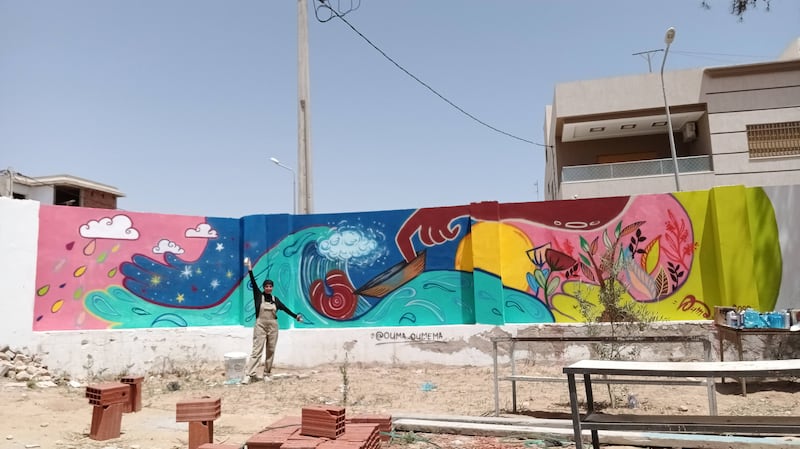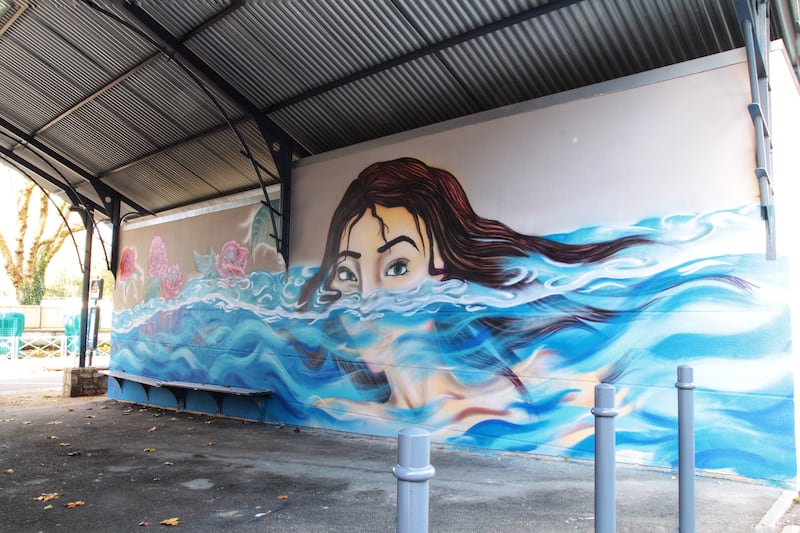Oumema Bouassida was still a teenager when she “tagged” her high school, beginning what would become a career focused on graffiti and street art.
It was shortly after Tunisia’s revolution in 2011, when Zine El-Abidine Ben Ali, the authoritarian president of 23 years, had fled. She had first come across graffiti on a TV news show. “I just wanted to do that on the street and be present as a woman on the street because before the revolution, as a hijabi Tunisian girl, we were always afraid of the street. It was always dominated by the police. You couldn’t be really free. So, I just wanted to express that finally I can do whatever I want on my Tunisian streets.”
Bouassida used paint cans to write the name of the neighbourhood and her high school on the walls, until she was caught. Her neighbour, who she says mistook her for a boy, started shouting. “When he discovered I was a girl, he was in shock.”
Afterwards, Bouassida went to her principal and asked for permission to finish her work. She got it. “I like to have meaning in my murals and I want them to be finished,” she says.
Now 31, Bouassida was born in Tunis and lives in the port city Sfax, from where she spoke to The Irish Times. She tags her work as Ouma.
Twelve years on, she says there is an active graffiti and street art community in Tunisia but, at that time, Bouassida thought she was the only one. She then discovered more artists through social media. “With the revolution and with the freedom that we gained through the revolution, graffiti artists started showing their art on Facebook. Some artists started vandalising the old houses of the politicians who ran away so it became a way of expressing the revolution.” In 2014, a street art festival called Djerbahood was set up in Erriadh village on Tunisia’s Djerba island, which saw roughly 150 local and international artists creating murals.
Bouassida actively mentors young people, including through workshops and summer schools. She herself studied in a fine arts school and became involved with various organisations that offered her painting materials, walls and the chance to practice.
Bouassida was described on news website the New Arab as “probably the first Tunisian woman artist to paint with a hijab”. Under the former dictator Ben Ali, who was in power from 1987 to 2011, there “was a war against any expression of religion”, Bouassida says. For her, supporting feminism is about allowing women the freedom to decide if they wear hijabs or not. “When I was young, starting to wear hijab, it was my choice. [But] I always had this fear walking on the street, I thought, ‘I don’t trust people.’” She says girls her age were taken to the police station and “violated”.
“Me, I didn’t experience a lot of violence but I experienced fear. It wasn’t really safe.”

As a result, she adapted her physical appearance. In particular, she began to dress in a “hip-hop” style, which she found compatible with being a young Muslim woman. “[I was] wearing baggy clothes. People will always confuse me with a boy because, with hip-hop clothing, I found it was modest. It represents what I need to wear as a hijabi.”
In the past, there were other authoritarian controls, including secret police. “You can’t even talk freely on the street about particular subjects – religion. You will be always afraid of the people around you,” Bouassida recalls.
Tunisia’s current president, Kais Saied – who has been in power since 2019 – has been accused of increased authoritarianism, consolidating and seizing wide-ranging powers and suppressing opposition. Despite this, Bouassida says she continues to be able to express the issues she cares about through her work.
“The issues that I make art about are females’ place, particularly the Tunisian woman. It’s the subject that I’m most interested in, based on my personal experiences and the stories of the females around me,” she says.
Feminism is “not only about my art, it’s a way of living. It’s a mindset”, she says. At the same time, she had pushback from women in France, for example, when she travelled, as they questioned her interpretation of feminism. “I think as an Arab woman, each woman could have her own definition,” Bouassida says. In Tunisia, “it’s not only about gender equal[ity]. It’s not about 50/50. It’s about accepting one another. It’s about understanding the situation that women are struggling about and making things easy for women and not for men to be an obstacle or a threat for achieving our dreams or our goals.”
[ ‘I need a safe place’: Sudanese flee war and brave the sea towards EuropeOpens in new window ]
She tries to reflect different types of feminism by painting portraits of women from various backgrounds and regions, including mothers focused on creating a better world for their children. She also tries to honour those who came before her. “As this new generation, we should appreciate the women before us that fought for other things that now we take for granted.”
Bouassida also creates art about the environment and other social issues, including the impact of emigration.
Regarding the environment, she says: “In Tunisia we have a big problem ... basically related to political things that are happening and political decisions. But I think there is also less awareness and we need to [educate] people. They don’t understand the impact of one person’s behaviour on the environment of all the country and of all the world so I think, as an artist, I have this responsibility to share knowledge about this topic and to act about it. I try to push people to think through my art about what they are doing to the environment.”
Tunisia – with a population of roughly 12 million – has recently found itself as the top departure point for people trying to cross the Mediterranean Sea to reach Europe. Those making the journey include Tunisians, who are escaping a poor economic situation, as well as Africans from other countries who are fleeing wars, dictatorships and crushing poverty.
“Our country, it’s a portal to Europe,” says Bouassida. “I tried to do this art piece where I did two hands, representing a boat. It expresses how we should accept one another despite our differences. We should live together and try to find solutions together.”
When she creates art, “the person in front of my wall can think about it differently based on his personal story or his personal experiences. It’s not like I’m imposing my own opinion but to push people to think about it and to think about the subject and to ask questions.”

Bouassida says peoples’ reactions are the most interesting part of her work. “It’s the thing that made me fall in love with graffiti and pursue this and continue doing it. When I’m painting in front of the wall, this communication that happens between me and the people who are passing by, from different backgrounds, different opinions, they come and ask me, ‘What is this and what’s the purpose?’ And I ask them in return to try and read the art and [see] what it can represent for them.”
She sees the impact of her work as “real and it’s durable. And when I finish my art piece, each mural has its own fight.” Some of her art from 2015 and 2016 is still visible on Tunisia’s walls. “They haven’t been vandalised or they haven’t been painted over. It’s the fact that the mural can live. It’s like it was accepted [by] the people.”
[ First Ugandan charged with ‘aggravated homosexuality’ punishable by deathOpens in new window ]
There have been some “funny reactions and some violent reactions but it’s a part of it. It never bothered me, it never made me think about stopping or it never made me feel angry about it. I’m coming to the street, which is a place for everyone. It’s not a gallery where they should be expected to love art or to appreciate it. People can do whatever they want with it.”
“When I finish my art piece, it doesn’t belong to me any more. It belongs to the street and it belongs to the people.”



















